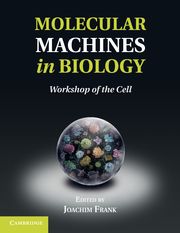Book contents
- Frontmatter
- Contents
- Contributors
- Figures and Tables
- Preface
- Introduction
- Chapter 1 Single-Molecule FRET: Technique and Applications to the Studies of Molecular Machines
- Chapter 2 Visualization of Molecular Machines by Cryo-Electron Microscopy
- Chapter 3 Statistical Mechanical Treatment of Molecular Machines
- Chapter 4 Exploring the Functional Landscape of Biomolecular Machines via Elastic Network Normal Mode Analysis
- Chapter 5 Structure, Function, and Evolution of Archaeo-Eukaryotic RNA Polymerases – Gatekeepers of the Genome
- Chapter 6 Single-Molecule Fluorescence Resonance Energy Transfer Investigations of Ribosome-Catalyzed Protein Synthesis
- Chapter 7 Structure and Dynamics of the Ribosome as Revealed by Cryo-Electron Microscopy
- Chapter 8 Viewing the Mechanisms of Translation through the Computational Microscope
- Chapter 9 The Ribosome as a Brownian Ratchet Machine
- Chapter 10 The GroEL/GroES Chaperonin Machine
- Chapter 11 ATP Synthase – A Paradigmatic Molecular Machine
- Chapter 12 ATP-Dependent Proteases: The Cell's Degradation Machines
- Index
- References
Chapter 7 - Structure and Dynamics of the Ribosome as Revealed by Cryo-Electron Microscopy
Published online by Cambridge University Press: 05 January 2012
- Frontmatter
- Contents
- Contributors
- Figures and Tables
- Preface
- Introduction
- Chapter 1 Single-Molecule FRET: Technique and Applications to the Studies of Molecular Machines
- Chapter 2 Visualization of Molecular Machines by Cryo-Electron Microscopy
- Chapter 3 Statistical Mechanical Treatment of Molecular Machines
- Chapter 4 Exploring the Functional Landscape of Biomolecular Machines via Elastic Network Normal Mode Analysis
- Chapter 5 Structure, Function, and Evolution of Archaeo-Eukaryotic RNA Polymerases – Gatekeepers of the Genome
- Chapter 6 Single-Molecule Fluorescence Resonance Energy Transfer Investigations of Ribosome-Catalyzed Protein Synthesis
- Chapter 7 Structure and Dynamics of the Ribosome as Revealed by Cryo-Electron Microscopy
- Chapter 8 Viewing the Mechanisms of Translation through the Computational Microscope
- Chapter 9 The Ribosome as a Brownian Ratchet Machine
- Chapter 10 The GroEL/GroES Chaperonin Machine
- Chapter 11 ATP Synthase – A Paradigmatic Molecular Machine
- Chapter 12 ATP-Dependent Proteases: The Cell's Degradation Machines
- Index
- References
Summary
Introduction
Protein synthesis is a central process for living entities. In all kingdoms of life, the key component of this process is the ribosome, a large macromolecular assembly composed of two distinctly sized subunits, whose cores are largely composed of ribosomal RNA, or rRNA. This molecular machine mediates the sequential incorporation of amino acids carried by the transfer RNAs (tRNAs) into the nascent protein chain. This process is also known as translation, because the genetic message encoded in the messenger RNA (mRNA) is deciphered into the language of proteins (Figure 7.1).
The functional complexity of molecular machines such as the ribosome is coupled to their structural intricacy. Whereas initial imaging by electron microscopy showed nothing but dense granules ∼200Å in diameter (Palade, 1955), decades later the development of cryo-electron microscopy (cryo-EM), combined with image processing methodology, brought evidence for the extreme complexity of the ribosome with its multiple mobile and flexible parts. Recently, as the quality of electron density maps has greatly improved thanks to methodological advances in this field (see Chapter 2 in this volume by Joachim Frank), new intermediate states have been observed and the dynamic behavior of the ribosome and its ligands has been further characterized in conjunction with other biophysical techniques such as X-ray crystallography, kinetic analysis, and single-molecule fluorescent resonance energy transfer (smFRET) (see Figure 7.2). Considering that the 3D reconstructions obtained by cryo-EM are snapshots representing functional states along the translation pathway, it is now widely acknowledged that this experimental approach has been indispensable in unraveling essential processes that cooperate in translation. Furthermore, many structural insights that have come from cryo-EM work currently drive experimental design in a wide range of studies of the ribosome, from biochemical to crystallographic studies and single-molecule FRET.
Information
- Type
- Chapter
- Information
- Molecular Machines in BiologyWorkshop of the Cell, pp. 117 - 141Publisher: Cambridge University PressPrint publication year: 2011
